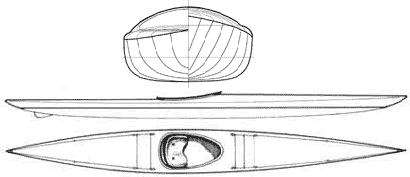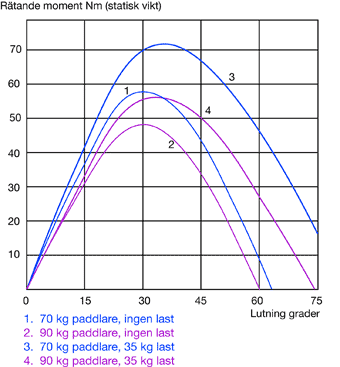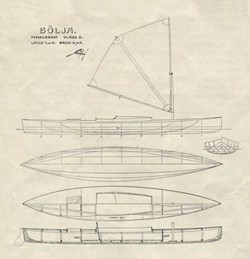Kavat
Latest updated Monday, February 5, 2024, 13 comments
Images | Particulars | More about | Background and history
Plans, Kavat - 125 EUR
Purchase
Kavat is a light, swift and extremely maneuverable medium volume kayak – quick, easy to turn and to stop and easily handled in high winds and waves. The hull form is closer to a traditional double ended fishing boat than to a contemporary kayak, which gives Kavat calm and easy movements in a short sea. Even inexperienced paddlers will feel safe and secure from the start. Stability is very high - initial and secondary – and approximately the same with or without camping gear. You can use a camera or binoculars or take on or off a jacket even in choppy seas.
Kavat is not a roomy kayak, but with a bit of ingenuity and discipline you can pack a weeks worth of gear. It can be built and used without unnecessary gadgets – rudder, hatches, bulkheads etc. Gear that doesn't exist cannot break, weighs not a single ounce, and costs not a penny (but if you find accessories irresistible, do not worry – the plans show them all).
Kavat has a high touring pace rather than high top speed – to achieve long distances with less effort. Due to the excellent maneuverability, Kavat is fun to use in rapids, for coastal surfing and rock hopping. Directional stability is dynamic - easy to turn at low speeds, good tracking at high speeds. The arched foredeck sheds water quickly, resulting in a dry paddling in short seas and a kayak that does not dive when driven hard into head seas.
Particulars

| Length¹ |
525/476 cm (overall/WL) |
| Beam |
57/56 cm (overall/WL) |
| Draft |
11 cm |
| Cockpit¹ |
80x40 cm |
| Height¹ |
29/22 cm (in front of/behind the cockpit) |
| Weight² |
16-21 kg |
| Displacement/volume⁶ |
130 kg/367 litre |
| Speed³ |
7.3/10.5 km/h |
| Prismatic coefficient |
0.57 |
| Wetted surface |
2.09 m² |
| Drag⁴ |
1.67/3.24 kp |
| Stability⁵ |
5/5 (initial/secondary stability) |
| Intended use |
Coastal and open sea touring. Lakes and rivers (rapids included). Day tours and exercise. |
* These dimensions can be adapted to suit personal needs or wishes.
** Depending on type of wood, equipment, care with epoxy usage, sanding etc. etc.
*** The speed numbers are based on mathematical standard formulas (175 lb paddler + 30 lb carco weight) and corrected from the kayaks actual performance om trials, on tours and in races.
⁴ Calculated resistance in 4 and 5 knots (at nominal load capacity).
⁵ Initial stability and secondary stability on a subjective scale, where 1 is very tippy and 5 is very stable.
⁶ Displacement is kayak + paddler + load. Count off the kayak weight to get the load capacity.

Stability
The curve shows the calculated stability with a static load, and therefore of limited use for a real paddler. The part of the curve near zero degrees indicates the initial (primary) stability – the steeper the curve, the more stable. The part of the curve left of the peak indicates end (secondary) stability – the higher and wider, the safer you feel edging the kayak. The position of the peak shows also how much the kayak can be leaned without tipping over. The part of the curve to the right of the peak with rapidly decreasing righting moment is almost impossible to take advantage of.
Plans
The plan sheets contain the information needed to build the kayak/canoe. Station molds, stems and construction details are full scale. For kayaks the recommended cockpit size is shown half scale with offsets for a full scale drawing and advice on altering the size. On the plans you will also find advice on how to shorten or lengthen the craft. Lines and construction drawings are in metric scale 1:10.

 The illustrated step-by-step building manual is in Swedish only, but it is available online in English: it covers all steps in detail and will guide first-time builders through the project.
The illustrated step-by-step building manual is in Swedish only, but it is available online in English: it covers all steps in detail and will guide first-time builders through the project.
Plans, Kavat - 125 EUR
Purchase
Minimum window dimensions to get your kayak out from the workshop:
57x29 cm
More on Kavat
Kavat is designed to be quickly and highly maneuverable. The most enjoyable paddling is often close to rocks, bars, shallows or in rapids. The volume coefficient is configured to give minimum resistance at a relaxed touring pace – 6-8 km/h – rather than a high top speed. You will get far with very little effort. Intended use is touring at sea or on lakes or in rivers, day touring, workout and, with the maneuverability also whitewater. Tracking is dynamic – easy turning in low speed, more directional stability at higher speeds.
Kavat is very handy in wind and waves. The hull shape is designed with an eye on the able peapods of the Swedish and Norwegian west coasts, primarily for the easy movements in rough seas. Even a beginner may handle surprisingly rough conditions, provided he or she trust the kayak and avoid making mistakes (leaning the wrong way or support strokes on the wrong side). The initial stability is high, and approximately the same with or without a touring load – it is easy to use a camera or binocular or take off a paddle jacket in waves. The hull shape lets the kayak handle waves from the side in a controlled manner – sliding downwave on the flat bottom, instead of "stumbling" over a V-shaped keel – leaving the paddler to sit relaxed and letting the kayak sort things out.
Ideal for beginners, but with the maneuverability and quick response, Kavat is also exciting for accomplished paddlers. A rudder is of no use (it actually compromises the maneuverability), but can be an added convenience for those who are used to that – store bought or home built. Without such addons, the kayak is simple and reliable and tricks the user into becoming a skilled paddler.
Kavat was designed before I had realized how useful and fun rolling is, and is therefore not as easy to roll as the Greenland-inspired kayaks – more stable both ways and with a higher aft deck. To have a reliable roll for safety reasons, or dependable support strokes and braces are no problems, but a beginner would do better learning the technique in a more suitable kayak. Do not enter a Greenland rolling contest in Kavat.
Kavat is a medium volume kayak. A paddler accustomed to touring will have no problems loading a week's worth of supplies. The inside is clean without any ribs or beams and very easy to load. The arched deck is comfortable with room for feet, knees and camping duffel, and sheds water quickly. Together with the low stems and volume far out in the ends, the kayak surfs well without tendencies to dive and is quite insensitive to wind.
 The midship station with an almost flat bottom and vertical sides give minimal draft and excellent stability, with or without load, and exciting surfs. The kayak is carefully balanced – windage, lateral plane, weight, volume etc – to be easily handled in all conditions. The sloping stem makes landings on ice easy. The kayak has dynamic tracking – easy to turn in low speed, more tracking in high. The elliptic cockpit can be built in a number of ways – some of them described in the manual – and the plans offer advice on adjustments in size and shape.
The midship station with an almost flat bottom and vertical sides give minimal draft and excellent stability, with or without load, and exciting surfs. The kayak is carefully balanced – windage, lateral plane, weight, volume etc – to be easily handled in all conditions. The sloping stem makes landings on ice easy. The kayak has dynamic tracking – easy to turn in low speed, more tracking in high. The elliptic cockpit can be built in a number of ways – some of them described in the manual – and the plans offer advice on adjustments in size and shape.
The manual also outlines some ways to build deck hardware, seat, back support, skeg etc.
Kavat - background and history
Kavat was my first kayak – designed 1993 to get out on the sea in a simpler and more efficient way than with our 36 ft ketch (now sold). The hull was modeled on the drafting table with an eye on some sources of inspiration. The sailing double enders of the Swedish west coast, primarily those from Kullabygden in the south: Marie Galante and Tunving. Their hulls, narrowed, lowered sand slightly drawn out became the Kavat hull. The jaktkanot of Blekinge, the Norse Oselver and Faering were also influential. Now and then I looked long and hard on pics of lLaplandriver boats, S:t Lawrence skiffs, whaleboats, and other successful traditional small crafts. Even the infamous "toksnipan" (crazy peapod) Rurik was analyzed – built by an old headstrong boatbuilder in the early 20th century in Vikhög, the heart of the most orthodox peapod district in southern Sweden – almost flatbottomed, with centerboard and mocked from the start. It became the fastest "peapod" in the sound between Denmark and Sweden. I was seeking speed, maneuverability, and sea-keeping qualities.
 Kayaks from Northern Kanada had some influence on the profile, but otherwise, they were too narrow and tippy for my needs.
Kayaks from Northern Kanada had some influence on the profile, but otherwise, they were too narrow and tippy for my needs.  An old Swedish canoe, Bölja, by Gerhard Högborg 1909, gave me the idea of creating room in the cockpit and still keep the deck low and unaffected by wind. An old ad for an American timber company and a kayak by Phil Bolger showed that a deck box could look OK.
An old Swedish canoe, Bölja, by Gerhard Högborg 1909, gave me the idea of creating room in the cockpit and still keep the deck low and unaffected by wind. An old ad for an American timber company and a kayak by Phil Bolger showed that a deck box could look OK.
The prototype, 485 cm long och 59 cm wide, was built quick-and-dirty in the summer 1994 and was tested in different conditions at sea and in rivers. I was quite pleased with my first attempt – maneuvering was excellent and I felt surprisingly safe and snug even in rough seas. But still, soon I began thinking of the next version. Early spring this was finished on the drawing table – the same hull but longer and with less beam (520x57 cm).
I was quite pleased with my first attempt – maneuvering was excellent and I felt surprisingly safe and snug even in rough seas. But still, soon I began thinking of the next version. Early spring this was finished on the drawing table – the same hull but longer and with less beam (520x57 cm).
Kavat no 2 was a success and I used it happily for a couple of years. Meanwhile, people I met began taking interest, sometimes tried the kayak and asking for plans. The plan's service slowly gained momentum.

Solid wood model of Kavat No 2. Metric scale 1:10
But of course, No 2 was not perfect in the long run. A few performance properties began to irritate. The flat foredeck had a tendency to dive in steep seas and green water splashed against the front edge of the deck box, soaking the paddler. Rolling the kayak seemed impossible with my severely limited rolling skills at the time. A wish list formed during the summers long distance touring, and the fall I designed version 3. The old No 2 was published as a free plan in "Kanotboken" (the Canoe Book), published in 1997.
The new Kavat Expedition got a whale deck, an elliptic cockpit rim, and a lower aft deck – and I was happy to note that the higher deck did not affect windage to any noticeable degree. But volume was much increased, as was room for feet and knees – and above all: Kavat Expedition surfed beautifully, was dry in headwinds and could be rolled (though not easily).
So I was satisfied. My Kavat was fast and stable, highly maneuverable and tracked well, rollable (sort of ;-) and comfortable. As good with a heavy load in open sea, as empty for a short workout or in streaming water.
The name, Kavat, has been questioned. Sounds like a chest of drawers from IKEA, I have been told (Kavat is an old obsolete word used about someone, mostly a child, who behaves more confidently than one would imagine – maybe "plucky" would suggest something similar in English?). There may be something IKEA-like in the name but since it is considered bad manners to rename ships and boats, Kavat it will be. The name came to me when I during the first summer and in some bad weather began realizing that the craft was far more "plucky" than I had envisioned during the design process.
Kavat has since inspired two more kayaks: Nomad, faster at the expense of some maneuverability, and Smart, extremely maneuverable at the expense of some top speed.

